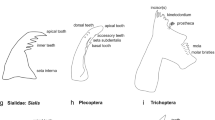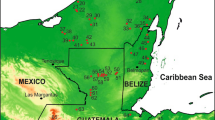Abstract
The aim of this study was to assess the value of phantom midge Chaoborus (Diptera: Chaoboridae) larvae as a palaeoenvironmental proxy in northern Europe. The presence of Chaoborus was examined in 80 small shallow lakes across Finland (60–70°N), based on their subfossil mandibles preserved in lake sediments. Chaoborus flavicans was present in 33 lakes, but was the most abundant midge taxon in only one of the lakes. Chaoborus crystallinus/obscurripes mandibles were present in two lakes. Statistical analyses showed that the distribution of Chaoborus was significantly correlated with lake depth and mean July air temperature. Chaoborus was absent in the northern study lakes, whereas the results indicated that C. flavicans was frequently found in small shallow lakes in southern Finland. Chaoborus flavicans was particularly abundant in fish-free, macrophyte-rich, dystrophic lakes, but absent in oligotrophic clear-water lakes having fish. The results of this study indicate that the subfossil mandibles of Chaoborus can provide valuable information in multiproxy palaeolimnological studies, especially when investigating past changes in water level and temperature in small shallow lakes in northern Europe.



Similar content being viewed by others
References
Barley, E. M., I. R. Walker, J. Kurek, L. C. Cwynar, R. W. Mathewes, K. Gajewski & B. P. Finney, 2006. A northwest North American training set: distribution of freshwater midges in relation to air temperature and lake depth. Journal of Paleolimnology 36: 295–314.
Bendell, B. E. & D. K. McNicol, 1987. Fish predation, lake acidity and the composition of aquatic insect assemblages. Hydrobiologia 150: 193–202.
Berendonk, T. & M. B. Bonsall, 2002. The phantom midge and a comparison of metapopulation structures. Ecology 83: 116–128.
Borkent, A., 1981. The distribution and habitat preferences of the Chaoboridae (Culicomorpha: Diptera) of the Holarctic region. Canadian Journal of Zoology 59: 122–133.
Brooks, S. J., P. G. Langdon & O. Heiri, 2007. The identification and use of Palaearctic Chironomidae larvae in palaeoecology. QRA Technical Guide No. 10. Quaternary Research Association, London: 276 pp.
Brundin, L., 1949. Chironomiden und andere Bodentiere der Südschwedischen Urgebirgsseen. Report of the Institute for Freshwater Research, Drottningholm 30: 1–914.
Bunbury, J. & K. Gajewski, 2008. Does a one point sample adequately characterize the lake environment for paleoenvironmental calibration studies? Journal of Paleolimnology 39: 511–531.
Dawidowicz, P., J. Pijanowska & K. Ciechomski, 1990. Vertical migration of Chaoborus larvae is induced by the presence of fish. Limnology and Oceanography 35: 1631–1637.
Eriksson, M. O. G., L. Henrikson, B. I. Nilsson, G. Nyman, H. G. Oscarson, A. E. Stenson & K. Larsson, 1980. Predator–prey relations important for the biotic changes in acidified lakes. Ambio 9: 248–249.
Frey, D. G., 1964. Remains of animals in Quaternary lake and bog sediments and their interpretation. Ergebnisse der Limnologie 2: 1–114.
Frey, D. G., 1986. Cladocera analysis. In Berglund, B. E. (ed.), Handbook of Holocene Palaeoecology and Palaeohydrology. John Wiley and Sons, New York: 667–692.
Frey, D. G., 1988. Littoral and offshore communities of diatoms, cladocerans and dipterous larvae, and their interpretation in paleolimnology. Journal of Paleolimnology 1: 179–191.
Hare, L. & A. Tessier, 1998. The aquatic insect Chaoborus as a biomonitor of trace metals in lakes. Limnology and Oceanography 43: 1890–1899.
Heiri, O., 2004. Within-lake variability of subfossil chironomid assemblages in shallow Norwegian lakes. Journal of Paleolimnology 30: 273–289.
Heiri, O. & A. F. Lotter, 2001. Effect of low count sums on quantitative environmental reconstructions: an example using subfossil chironomids. Journal of Paleolimnology 26: 343–350.
Heiri, O. & A. F. Lotter, 2003. 9000 years of chironomid assemblage dynamics in an Alpine lake: long-term trends, sensitivity to disturbance, and resilience of the fauna. Journal of Paleolimnology 30: 273–289.
Hofmann, W., 1978. Analysis of animal microfossils from the Großer Segeberger See. Archiv für Hydrobiologie 82: 316–346.
Hongve, D., 1975. On the ecology and distribution of Chaoborus (Chaoboridae, Diptera) from the upper Romerike District, south-east Norway. Norwegian Journal of Entomology 22: 49–57.
Horppila, J. & A. Liljendahl-Nurminen, 2005. Clay–turbid interactions may not cascade—a reminder for lake managers. Restoration Ecology 13: 242–246.
Hynynen, J., A. Palomäki, J. J. Meriläinen, A. Witick & K. Mäntykoski, 2004. Pollution history and recovery of a boreal lake exposed to a heavy bleached pulping effluent load. Journal of Paleolimnology 32: 351–374.
Ilyashuk, E. A., B. P. Ilyashuk, D. Hammarlund & I. Larocque, 2005. Holocene climatic and environmental changes inferred from midge records (Diptera: Chironomidae, Chaoboridae, Ceratopogonidae) at lake Berkut, southern Kola Peninsula, Russia. The Holocene 15: 897–914.
Jager, I. S. & N. Walz, 2002. Chaoborus flavicans (Diptera) is an oxy-regulator. Archiv für Hydrobiologie 155: 401–411.
Johnson, M. G., J. R. M. Kelso, O. C. McNeil & W. B. Morton, 1990. Fossil midge associations and the historical status of fish in acidified lakes. Journal of Paleolimnology 3: 113–127.
Kansanen, P. H., T. Jaakkola, S. Kulmala & R. Suutarinen, 1991. Sedimentation and distribution of gammaemitting radionuclides in bottom sediments of southern Lake Päijänne, Finland, after the Chernobyl accident. Hydrobiologia 222: 121–140.
Kauppila, T., T. Moisio & V. P. Salonen, 2002. A diatom-based inference model for autumn epilimnetic total phosphorus concentration and its applications to a presently eutrophic boreal lake. Journal of Paleolimnology 27: 261–273.
Korhola, A., H. Olander & T. Blom, 2000. Cladoceran and chironomid assemblages as quantitative indicators of water depth in subarctic Fennoscandian lakes. Journal of Paleolimnology 24: 43–54.
Korhola, A., K. Vasko, H. T. T. Toivonen & H. Olander, 2002. Holocene temperature changes in northern Fennoscandia from chironomids using bayesian modelling. Quaternary Science Reviews 21: 1841–1860.
Larocque, I., 2001. How many chironomid head capsules are enough? A statistical approach to determine sample size for palaeoclimatological reconstructions. Palaeogeography, Palaeoclimatology, Palaeoecology 172: 133–142.
Liljendahl-Nurminen, A., 2006. Invertebrate predation and trophic cascades in a pelagic food web—the multiple roles of Chaoborus flavicans (Meigen) in a clay-turbid lake. PhD thesis, University of Helsinki: 35 pp.
Liljendahl-Nurminen, A., J. Horppila, P. Eloranta, T. Malinen & L. Uusitalo, 2002. The seasonal dynamics and distribution of Chaoborus flavicans larvae in adjacent lake basins of different morphometry and degree of eutrohication. Freshwater Biology 47: 1283–1295.
Luoto, T. P., 2009. Subfossil Chironomidae (Insecta: Diptera) along a latitudinal gradient in Finland: development of a new temperature inference model. Journal of Quaternary Science 24: 150–158.
Luoto, T. P., L. Nevalainen & K. Sarmaja-Korjonen, 2008. Multiproxy evidence for the ‘Little Ice Age’ from Lake Hampträsk, southern Finland. Journal of Paleolimnology 40: 1097–1113.
Nevalainen, L., 2004. Karkkilan Arapisto-järven paleolimnologinen kehitys vesikirppujen ja piilevien kuvastamana [Paleolimnological development of Lake Arapisto in Karkkila, southern Finland, reflected by cladocerans and diatoms]. Unpublished M.Sc. thesis, Department of Geography, University of Helsinki, Finland (in Finnish).
Nevalainen, L., 2008. Parthenogenesis and gamogenesis in seasonal succession of chydorids (Crustacea, Chydoridae) in three low-productive lakes as observed with activity traps. Polish Journal of Ecology 56: 85–97.
Nevalainen, L. & K. Sarmaja-Korjonen, 2008. Intensity of autumnal gamogenesis in chydorid (Cladocera, Chydoridae) communities in southern Finland, with a focus on Alonella nana (Baird). Aquatic Ecology 42: 151–163.
Nevalainen, L., T. P. Luoto & K. Sarmaja-Korjonen, 2008. Late Holocene water-level changes in lake Iso Lehmälampi, southern Finland, reflected in subfossil cladocerans and chironomids. Studia Quaternaria 25: 33–42.
Ouimet, C., 2001. Implications of Chaoborus pupation and ecdysis in cold water. Freshwater Biology 46: 1169–1177.
Paasivirta, L., 1982a. Saarijärven Pyhä-Häkin kansallispuiston ja sen lähiympäristön metsäjärvien makroskooppinen pohjaeläimistö. Jyväskylän yliopiston biologian laitoksen tiedonantoja [Macroscopic bottom fauna in the national park of Pyhä-Häkli in Saarijärvi and in the small forest lakes in close proximity]. Bulletin of the University of Jyväskylä 29: 31–39 (in Finnish).
Paasivirta, L., 1982b. Saarijärven Pyhä-Häkin kansallispuiston ja sen lähiympäristön metsäjärvien koskikorento-, sudenkorento-, kaislakorento-, verkkosiipis- ja sääskilajisto. Jyväskylän yliopiston biologian laitoksen tiedonantoja [Plecoptera, Odonata, Megaloptera, Neuroptera and Nematocera species in the national park of Pyhä-Häkli in Saarijärvi and in the small forest lakes in close proximity]. Bulletin of the University of Jyväskylä 29: 40–49 (in Finnish).
Paasivirta, L., 1989. Pohjaeläimistötutkimuksen liittäminen järvisyvännealueiden seurantaan Vesi- ja ympäristöhallinnon monistesarja [Studies on the bottom fauna in deep-water follow-ups]. Publications of the Finland’s Environmental Administration 164: 1–69 (in Finnish).
Paasivirta, L., T. Lahti & T. Perätie, 1988. Emergence phenology and ecology of aquatic and semi-terrestrial insects on a boreal raised bog in Central Finland. Holarctic Ecology 11: 96–105.
Rautio, M., 1998. Community structure of crustacean zooplankton in subarctic ponds—effects of altitude and physical heterogeneity. Ecography 21: 327–335.
Sæther, O. A., 1997. Diptera Chaoboridae, Phantom midges. In Nilsson, A. (ed.), Aquatic Insects of North Europe 2. Apollo Books, Stenstrup: 149–161.
Sarmaja-Korjonen, K., 2002. Multi-proxy data from Kaksoislammi Lake in Finland: dramatic changes in the late Holocene cladoceran assemblages. Journal of Paleolimnology 28: 287–296.
Sarmaja-Korjonen, K., M. Nyman, S. Kultti & M. Väliranta, 2006. Paleolimnological development of Lake Njargajavri, northern Finnish Lapland, in a changing Holocene climate and environment. Journal of Paleolimnology 35: 65–81.
Scholz, F. & I. Zerbst-Boroffka, 1998. Environmental hypoxia affects osmotic and ionic regulation in freshwater midge-larvae. Journal of Insect Physiology 44: 427–436.
Smol, J. P., 2002. Pollution of Lakes and Rivers: A Paleoenvironmental Perspective. Arnold Publishers, London.
Stenson, J. A. E., 1978. Differential predation by fish on two species of Chaoborus (Diptera, Chaoboridae). Oikos 31: 98–101.
Stenson, J. A. E., 1981. The role of predation in the evolution of morphology, behaviour and life history of two species of Chaoborus. Oikos 37: 323–327.
Sweetman, J. N. & J. P. Smol, 2006. Reconstructing fish populations using Chaoborus (Diptera: Chaoboridae) remains—a review. Quaternary Science Reviews 25: 2013–2023.
Szeroczyńska, K. & K. Sarmaja-Korjonen, 2007. Atlas of Subfossil Cladocera from Central and Northern Europe. Friends of the Lower Vistula Society, Świecie, Poland.
Thienemann, A., 1925. Die binnengewässer nittelewopas eine limnologische einfuhrung. Binnengewässer 1: 1–225.
Uutala, A. J., 1990. Chaoborus (Diptera: Chaoboridae) mandibles—paleolimnological indicators of the historical status of fish populations in acid-sensitive lakes. Journal of Paleolimnology 4: 139–151.
Uutala, A. J. & J. P. Smol, 1996. Paleolimnological reconstructions of long-term changes in fisheries status in Sudbury area lakes. Canadian Journal of Fisheries and Aquatic Sciences 53: 174–180.
Walker, I. R., 2001. Midges: Chironomidae and related Diptera. In Smol, J. P., H. J. B. Birks & W. M. Last (eds), Tracking Environmental Change using Lake Sediments: Zoological Indicators. Developments in Paleoenvironmental Research, Vol. 4. Kluwer Academic Publishers, Dordrecht: 43–66.
Wissel, B., W. J. Boeing & C. W. Ramcharan, 2003. Effects of water color on predation regimes and zooplankton assemblages in freshwater lakes. Limnology and Oceanography 48: 1965–1976.
Yan, N. D., R. W. Nero, W. Keller & D. C. Lasenby, 1985. Are Chaoborus larvae more abundant in acidified than in non-acidified lakes in Central Canada? Holarctic Ecology 8: 93–99.
Yan, N. D., W. Keller, H. J. MacIsaac & L. J. McEachern, 1991. Regulation of zooplankton community structure of an acidified lake by Chaoborus. Ecological Applications 1: 52–65.
Acknowledgements
We are grateful to Seija Kultti, Susanna Kihlman, Anu Hakala, and the Kevo Research Station staff for assistance with the fieldwork. Thanks are also due to Mikko Haaramo for helping with the photographs and Kaarina Sarmaja-Korjonen for fruitful discussions. The two anonymous reviewers are thanked for their constructive reviews of our manuscript. This study was funded by the Finnish Graduate School in Geology, Finnish Entomological Society, and Nordenskiöld Foundation for Tomi P. Luoto and by the Ephippium Project (Academy of Finland, Grant No. 1107062) for Liisa Nevalainen.
Author information
Authors and Affiliations
Corresponding author
Additional information
Guest editors: K. Buczkó, J. Korponai, J. Padisák & S. W. Starratt
Palaeolimnological Proxies as Tools of Environmental Reconstruction in Fresh Water
Rights and permissions
About this article
Cite this article
Luoto, T.P., Nevalainen, L. Larval chaoborid mandibles in surface sediments of small shallow lakes in Finland: implications for palaeolimnology. Hydrobiologia 631, 185–195 (2009). https://doi.org/10.1007/s10750-009-9810-0
Published:
Issue Date:
DOI: https://doi.org/10.1007/s10750-009-9810-0




